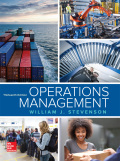
EBK OPERATIONS MANAGEMENT
13th Edition
ISBN: 8220103675987
Author: Stevenson
Publisher: YUZU
expand_more
expand_more
format_list_bulleted
Concept explainers
Question
Chapter 18, Problem 5P
a.
Summary Introduction
To determine: The system utlization rate.
Introdution:
System utilization refers to percentage amount of capacity which is utilized or we can say that actual output divided by potential output. It is operational metric for business which indicate aggregate productive capacity.
b.
Summary Introduction
To determine: Average number of customer waiting
Introduction: Average number of customers in the system is the average number of system which is used for the production purpose.
c.
Summary Introduction
To determine: The average time customer waiting hours.
d.
Summary Introduction
To determine: Probability that both ambulances will be busy when a call comes in
Expert Solution & Answer
Want to see the full answer?
Check out a sample textbook solution
Students have asked these similar questions
A fast-food restaurant offers a variety of products: from pre-made packaged
sandwiches to milkshakes with different flavors. Many customers order one item
time, other customers order multiple items. Sometimes customers buy the pre-
made items, and some customers actually ask the restaurant to cook their food
while they wait. The restaurant manager has kept careful records of some
queuing statistics over several weeks. According to this data, the staff needs 4
minutes on average to serve a random customer. On average, the restaurant
served 120 customers on a given day. This restaurant is open from 9 AM to 9 PM
every day, and has a single service counter. If you want to help the manager
measure this restaurant's waiting line performance, which of the following should
you use?
Exponential Service Rate Model
The Finite Source Model
Constant Service Rate Model
O The multi phase single channel model
In an M/MA queueing system, the arrival rate is 4 customers per hour and the service rate is 6 customers per hour. If the service
process is automated (resulting in no variation in service times but the same service rate), what will be the resulting performance
measurements? (Round your answers to 3 decimal places.)
a. What is the utilization?
Utilization
b. What is the expected number of customers in the system (L)?
Number of customers
c. What is the expected waiting time (in hours) for the system (W)?
Waiting time(in hours)
d. What is the expected number of customers in the queue(La)?
< Prev
2 of 5
Next
raw
lill
A local fast food restaurant wants to analyze its drive-thru window. At this time, the only information known is the average number of customers in the system (4.00) and the average time a customer spends at the restaurant (1.176 minutes). What is the arrival rate (λ) and the service rate (μ)?
Group of answer choices
Arrival rate = 4.25 customers/min. Service rate = 3.4 customers/min.
Arrival rate = .29 customers/min. Service rate = .24 customers/min.
Arrival rate = 3.4 customers/min. Service rate = 4.25 customers/min.
Arrival rate = .24 customers/min. Service rate = .29 customers/min.
None of the above answers are correct
Chapter 18 Solutions
EBK OPERATIONS MANAGEMENT
Ch. 18 - Prob. 1DRQCh. 18 - Why do waiting lines form even though a service...Ch. 18 - Prob. 3DRQCh. 18 - Prob. 4DRQCh. 18 - What approaches do supermarkets use to offset...Ch. 18 - Prob. 6DRQCh. 18 - Prob. 7DRQCh. 18 - Prob. 8DRQCh. 18 - Prob. 9DRQCh. 18 - Prob. 1TS
Ch. 18 - Prob. 2TSCh. 18 - Prob. 3TSCh. 18 - Prob. 1CTECh. 18 - Prob. 2CTECh. 18 - Prob. 3CTECh. 18 - The owner of Eat Now Restaurant implemented an...Ch. 18 - Prob. 5CTECh. 18 - Prob. 1PCh. 18 - Prob. 2PCh. 18 - Prob. 3PCh. 18 - Prob. 4PCh. 18 - Prob. 5PCh. 18 - Prob. 6PCh. 18 - Prob. 7PCh. 18 - Prob. 8PCh. 18 - Prob. 9PCh. 18 - Prob. 10PCh. 18 - Prob. 11PCh. 18 - Prob. 12PCh. 18 - Prob. 13PCh. 18 - Prob. 14PCh. 18 - Prob. 15PCh. 18 - A priority waiting system assigns arriving...Ch. 18 - Prob. 17PCh. 18 - Prob. 18PCh. 18 - Prob. 1CQ
Knowledge Booster
Learn more about
Need a deep-dive on the concept behind this application? Look no further. Learn more about this topic, operations-management and related others by exploring similar questions and additional content below.Recommended textbooks for you
 Practical Management ScienceOperations ManagementISBN:9781337406659Author:WINSTON, Wayne L.Publisher:Cengage,
Practical Management ScienceOperations ManagementISBN:9781337406659Author:WINSTON, Wayne L.Publisher:Cengage,

Practical Management Science
Operations Management
ISBN:9781337406659
Author:WINSTON, Wayne L.
Publisher:Cengage,